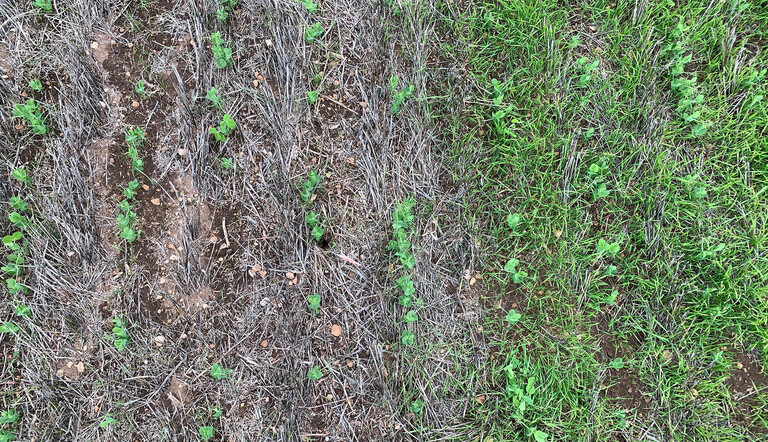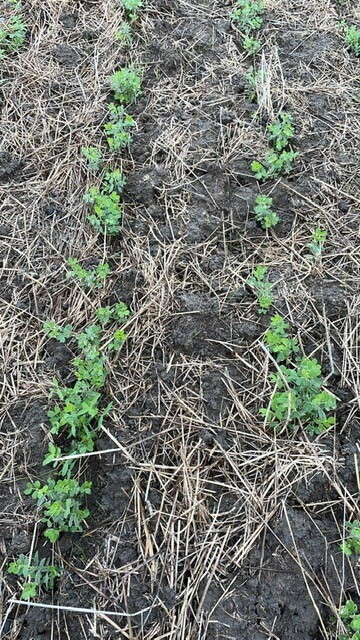
Pulse crop herbicide benefits continue to mount

In a grassy paddock near Kadina in South Australia, the excellent weed control in field peas provided by Ultro pre-emergent herbicide is shown on the left, compared with an untreated area on the right.
CONSISTENT control of grass weeds across indifferent seasons, including of herbicide-resistant types, and wider benefits for entire cropping systems is continuing to raise the profile and justify grower investment in a specialist pulse crop herbicide.
Ultro® contains a new herbicide mode of action (Group 23) and it is being targeted for use in pulse crops, where it is consistently achieving higher levels of grass weed control than many industry standards. The pre-emergent herbicide can be used in faba beans, lentils, field peas, chickpeas, lupins, vetch and broad beans across Australia, as well as in winter fallow.
Glyphosate and clethodim-resistant grass weeds are posing problems for various southern Australian growers, however Ultro is now taking the pressure off some traditional herbicide options and is helping to clean-up paddocks for future crops.
Meanwhile, in Western Australia, many growers have particularly targeted the use of Ultro® pre-emergent herbicide in lupins as an alternative to propyzamide applications for ryegrass, brome and barley grass control due to its robust efficacy and significant benefits for their whole farm weed management plans.
Putting a focus on the whole farming system benefit from each year’s weed control is becoming more recognised. Using Ultro within the pulse phase of crop rotations is benefiting following cereal crops and, thereby, enhancing its cost-effectiveness. The early weed control with Ultro allows improved crop competition against weeds, while excellent root pruning on the later remaining grasses assists the effectiveness of post-emergent selective herbicides.
Andrè Sabeeney, Market Development Manager with ADAMA Australia in SA, said Ultro had been used especially in high value lentil crops, which also generally provided reduced competition against weeds, as well as in some faba bean and field pea crops.
He said he considered it the ideal pre-emergent herbicide for use in pulse crops.
“What’s been impressive is that Ultro has delivered some of the most consistent results in control despite the extremes we have experienced in seasons over the last couple of years,” Andrè said.
“It has just been so much more consistent than the alternatives used in these cropping systems and that has been a real benefit.”
Ultro’s high water solubility compared with other herbicides allowed it to perform extremely well in the dry conditions last season and it offered good persistence, which took some pressure off and enabled better efficacy from post-emergent clethodim treatments.
“The mix of a good, robust pre-emergent such as Ultro, followed by an effective post-emergent grass weed herbicide, helps reduce seedset and delay the development of herbicide resistance,” Andrè said
“Ultro controls most annual grass weeds, it’s not broken down by sunlight, it moves off stubble well and it offers good length of control provided the appropriate rate is applied according to soil type, with higher rates used on heavier paddocks.”
Bevan Addison, Market Development Manager with ADAMA Australia in WA, said after recognising the benefits of Ultro for grass control in their pulse crops and for their broader cropping system, growers were now driving its use and rate of application, with higher rates tending to be used on heavier soil types.
“As part of the full system, Ultro is showing it is better than anything else and it results in reduced panicles and seedset. It achieves earlier control of weeds – many simply don’t come out of the ground – and this also reduces root disease build-up for following seasons,” Bevan said.
He said Ultro-treated grass weeds can also remain greener for longer and in particularly high weed pressure paddocks requiring crop-topping, this allows these applications to be delayed, reducing the risk of crop damage from the operation and concern over grain maximum residue limits.
At Kadina in SA, AW Vater & Co Agronomist Zack Zweck said various growers had used Ultro in combination with Reflex® pre-emergent herbicide and achieved good success.
“It has controlled early ryegrass and brome grass, allowing for delayed in-crop grass sprays. It has also helped the in-crop grass sprays work better,” Zack said.
At Wycheproof in Victoria, Elders Agronomist Roy Daykin said Ultro applications with simazine and Spraytop® had performed well in numerous instances.
“Feedback from growers in recent seasons has been very positive, with good control of ryegrass, including ryegrass with suspected resistance to glyphosate. It has taken a great deal of pressure off Group 1 post-emergent chemistry,” Roy said.
“The solubility of carbetamide (the active ingredient in Ultro) compared with propyzamide seems to fit our dryland programs better.”
Andrè said to aid herbicide resistance management, ADAMA Australia recommended limiting the use of Ultro to once every four years.
He said in tight cropping rotations, careful consideration would need to be given to herbicide choice, however in more common rotations featuring pulses, canola and cereals, an application every four years would be easy to achieve and would allow rotation of all herbicide options in the different phases.
For further information on the use of Ultro herbicide in pulse crops, growers can contact their local ADAMA Australia representative or visit ADAMA.com.
Media Contact:
Holly Hartley | Marketing Campaign Manager | D: 0473 210 903 |

